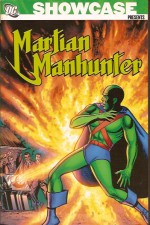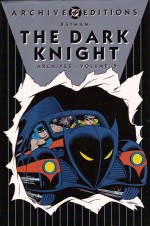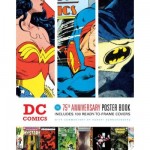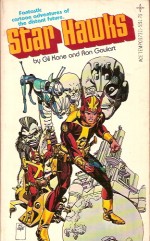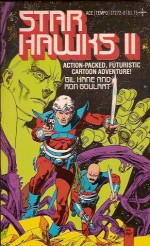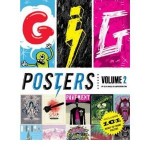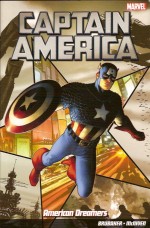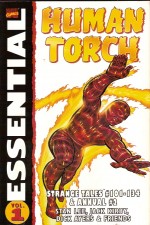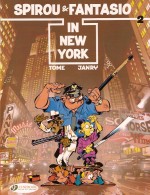
By Tome & Janry, translated by Jerome Saincantin (Cinebook)
ISBN: 978-1-84918-054-2
For most English-speaking comic fans and collectors Spirou is probably Europe’s biggest secret. The character is a rough contemporary – and calculated commercial response – to Hergé’s iconic Tintin, whilst the comic he has headlined for decades is only beaten in sheer longevity and manic creativity by our own Beano and Dandy.
Conceived at Belgian Printing House by Jean Dupuis in 1936, a magazine targeting a juvenile audience debuted on April 21st 1938; neatly bracketed by DC Thomson’s The Dandy which launched on 4th December 1937 and The Beano on July 30th 1938. It was edited by Charles Dupuis (a mere tadpole, only 19 years old, himself) and took its name from the lead feature, which recounted the improbable adventures of a plucky Bellboy/lift operator employed by the Moustique Hotel (a reference to the publisher’s premier periodical Le Moustique).
Joined on June 8th 1939 by a pet squirrel, Spip (the longest running character in the strip after Spirou himself) the series was conceived by French artist Robert Velter who signed himself Rob-Vel.
A Dutch language edition ‘Robbedoes’ debuted a few weeks later and ran more-or-less in tandem with the French parent comic until it was cancelled in 2005.
The bulk of the comic was taken up with cheap American imports – Fred Harman’s Red Ryder, William Ritt & Clarence Gray’s ‘Brick Bradford’ and Siegel & Shuster’s landmark ‘Superman’ – although home-grown product crept in too. Most prominent were ‘Tif et Tondu’ by Fernand Dineur (which ran until the1990s) and ‘L’Epervier Blue’ by Sirius (Max Mayeu) and they were soon joined by comic-strip wunderkind Joseph Gillain – “Jijéâ€.
Legendarily, during World War II Jijé drew the entire comic by himself, including home grown versions of banned US imports and also assumed production of the Spirou strip where he created the current co-star Fantasio).
Except for a brief period when the Nazis closed the comic down (September 1943 to October 1944 whilst the Allies liberated Belgium) Spirou and its boyish star – now a globe-trotting journalist – have continued their weekly exploits in unbroken four-colour glory.
Among the other myriad major features that began within those hallowed pages are ‘Jean Valhardi’ (by Jean Doisy & Jije), ‘Blondin et Cirage’ (Victor Hubinon), Buck Danny, ‘Jerry Spring’, ‘Les Schtroumpfs’, ‘Gaston Lagaffe’ and a certain laconic cowboy named Lucky Luke.
Spirou the character (whose name translates as both “squirrel†and “mischievousâ€) has starred in the magazine for most of its life, evolving under a series of creators into an urbane yet raucous fantasy/adventure hero with the accent heavily on light humour. With comrade and rival Fantasio and crackpot inventor the Count of Champignac, Spirou travels to exotic places, uncovering crimes, revealing the fantastic and garnering a coterie of exotic arch-enemies.
During the War when Velter went off to fight, his wife Blanche Dumoulin took over the strip using the name Davine, assisted by Luc Lafnet. Dupuis assumed control of and rights to the strip in 1943, assigning it to Jijé who handed it to his assistant André Franquin in 1946. It was the start of a golden age.
Among Franquin’s innovations were the villains Zorglub and Zantafio, Champignac and one of the first strong female characters in European comics, rival journalist Seccotine (renamed Cellophine in this current English translation), but his greatest creation – one he retained on his departure in 1969 – was the incredible magic animal Marsupilami (first seen in Spirou et les héritiers in 1952), now a star of screen, plush toy store, console and albums all his own.
From 1959 the writer Greg and background artist Jidéhem assisted Franquin but by 1969 the artist had reached his Spirou limit and resigned, taking his mystic yellow monkey with him. He was succeeded by Jean-Claude Fournier who updated the feature over the course of nine stirring adventures that tapped into the rebellious, relevant zeitgeist of the times with tales of environmental concern, nuclear energy, drug cartels and repressive regimes.
By the 1980s the series seemed to stall: three different creative teams alternated on the serial: Raoul Cauvin & Nic Broca, Yves Chaland and the author of the adventure under review here: Philippe Vandevelde writing as Tome and artist Jean-Richard Geurts AKA Janry. These last adapted and referenced the beloved Franquin era and revived the feature’s fortunes, producing fourteen wonderful albums between 1984 and 1998. This one, originally entitled ‘Spirou à New-York’ from 1987, was their seventh and the 39th collection of the venerable comedy sagas.
Since their departure Lewis Trondheim and the team of Jean-Davide Morvan & Jose-Luis Munuera have brought the official album count to fifty (there also are a bunch of specials, spin-offs and one-shots, official and otherwise)…
In the Big Apple there is war between two criminal factions. The Mafia are steadily losing ground and men to the insidiously encroaching Chinese Triad of the mysterious Mandarin.
Don Vito “Lucky” Cortizone is advised that it’s due to an incredible run of bad luck and undertakes to find and “recruit†the luckiest person on Earth to turn his gang’s fortunes around…
Meanwhile in Paris Spirou and Fantasio are broke again. Starving with days until payday, they scrape just enough coins together from beneath the sofa cushions for one last frozen pizza…
The tasteless American import has a key inside which almost chokes Fantasio but also claims that they’ve won a million dollars. All they have to do is collect it in person from Lucky’s Bank in New York. Their fortunes are rapidly changing: an assignment from the unscrupulous editor of Turbine Magazine gives them airplane tickets and the promise of work covering a car-ball match in NYC – but only if they leave immediately…
Once in the Big Apple the story shifts into lavishly ludicrous high gear: Cortizone -permanently stuck under a rain cloud which follows him everywhere – hides nothing from the lads but appeals to their greed and fellow feeling to help him out of his tight spot. The implacable, insidious Chinese are beating him at every turn. It’s almost like magic…
But as his men continue to fall around him and Triad assassins keep getting closer and closer, The Don wants to carry out a few tests first – just to see how lucky Fantasio actually is…
Meanwhile, the Mandarin and his reluctant but particularly effective wizard stooge have gotten wind of the scheme and move to negate the Europeans’ influence by kidnapping Spip. And even if it doesn’t forestall their interference, at least the enigmatic mastermind will have something new and exotic to eat…
The diabolical cut-and-thrust shenanigans lead to a daring rescue mission on the Mandarin’s skyscraper citadel and an inevitably spectacular showdown in the skies over New York…
With hilarious supernatural overtones, clever criminal capers, sly digs at American movies-as-culture and daring dabblings with racial and cultural stereotypes/archetypes, all leavened with witty in-jokes, spoofs, lampoons and visual puns, this fast-paced, riotous rollercoaster romp is sheer comicbook poetry that it would be a crime to miss.
This type of thrilling mystery, weird science, light adventure and broad slapstick is a pure refreshing joy in a market far too full of adults-only carnage and testosterone-fuelled breast-beating. Easily accessible to readers of all ages and drawn with all the welcoming style and panache that makes Asterix, Lucky Luke and Iznogoud so compelling, this is another cracking read from a long line of superb exploits which should soon be as much a household name as those series – and even Tintin himself…
Original edition © Dupuis, 1987 by Tome & Janry. All rights reserved. English translation 2010 © Cinebook Ltd.

